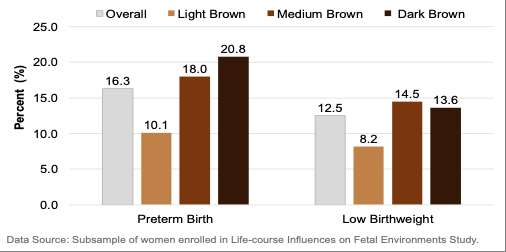April 17, 2019: Jaime Slaughter-Acey, PhD, MPH
For over 40 years now, Black infants have had an infant mortality rate ~double the rate of White infants.1,2 Likewise, rates for other perinatal indicators of the nation’s health, preterm birth (<37 weeks’ gestation), low birthweight (<2500 grams), and maternal morbidity and mortality, also reflect longstanding racial disparities of similar or greater magnitude. Last year (2018), NY Times Magazine author Linda Villarosa brought renewed attention to a very old problem by asking the question, “Why America’s Black Mothers and Babies are in a Life or Death Crisis?[JS1] ” Ms. Villarosa correctly answered, it “has everything to do with the lived experiences of being a Black woman in American.”
Empirical research consistently shows racial disparities in perinatal health outcomes persist despite consideration for socioeconomic status and other traditional risk factors (e.g., health behaviors, chronic comorbidities). In the last two decades, population health researchers have come to acknowledge race as a social construct,3,4 with an ever-increasing body of evidence studying racism as a social determinant of maternal and infant health outcomes.[JS2] 5-7 Still, most racial disparities research fails to consider skin color, our most visible physical attribute, it social meaning and intersection with race.
For Black Americans, racism and colorism are part and parcel of daily lived experiences that extend over the lifespan—birth, childhood, adolescence, and adulthood—with intergenerational implications.8 Racism is a system for continued maintenance of social dominance and oppression that structures opportunities and assigns value to interpersonal exchange based on individuals perceived or assigned race/ethnic group.9 Colorism is a phenotype-based continuum that assigns privilege and disadvantage based upon the color of one’s skin.10 Privilege is allocated to individuals with lighter complexions and more European-like features while disadvantage is assigned to those with darker complexions and more Afrocentric features.8,11,12 Colorism is an institutional outgrowth of white supremacy and is more prevalent in societies that have a history of slavery and/or colonization.10 Thus, skin tone is not simply a physical trait reflective of value neutral bodily differences. 10
Figure 1. Colorism operates across multiple social contexts
A popular misnomer about colorism is that it functions only within communities of color as a form of internalized racism. In truth, colorism operates across multiple social contexts since it manifests from cultural racism, individual and societal beliefs in the supremacy of one group over another group that have become rooted into the cultural standards of our institutions, ideology, and everyday actions.13 Therefore, one can experience colorism not just from within one’s own racial/ethnic group (in-group colorism), but from other racial/ethnic groups and society as a whole (out-group colorism), Figure 1.
Experiences of marginalization related to racism and colorism may combine, overlap or intersect with other systems of oppression related to aspects of social identity to affect health. America’s Black women face multiple and simultaneous sources of chronic stress, stigma and discrimination that are tied to her identities as a woman, a racial/ethnic minority, and her skin color, Figure 2. The social significance of skin tone for Black women has been documented in relation to educational and economic attainment, the marital market, and psychosocial attributes including self-esteem, racial identity and socialization, and perceived stress (See Herring, Keith, & Horton, 2004; Keith 2009; Adams et al, 2016 ). Research investigating the impact of colorism on Black women’s health outcomes is in its infancy, but existing studies suggest skin tone, as a proxy for colorism, is a predictor of systolic and diastolic blood pressure,16,17 perceived stress,18 and body mass index,16,19 and allostatic load for Black women.20
Figure 2. Race, Skin Color, and Gender intersect to affect Health for Women of Color
There is a need for population health research to consider the implications of racism and colorism on the health of Black women, especially with regard to perinatal health outcomes given the magnitude of Black-White disparities. Through funding from the Russell Sage Foundation[JS3] , my research team is examining the multidimensional nature of race and its intersection with skin color in relation to the African American women’s birth outcomes—specifically preterm birth, low birthweight, and fetal growth restriction. Preliminary findings among a subsample (n=700) of Black women living in Metropolitan Detroit, MI suggest maternal skin tone is an important predictor of preterm birth and low birthweight risk (Figure 3).
Figure 3. % PTB and LBW in Black Women (N=700), Stratified by Self-reported Skin Tone, 2009-2011
Disclaimer: This work has been supported in part by Grant # 96-18-03 from the Russell Sage Foundation to Dr. Slaughter at the University of Minnesota. The LIFE study was funded by NIH grant no. [R01HD058510] to Dr. Misra at Wayne State University. Any opinions expressed are those of the author(s) alone and should not be construed as representing the opinions of the Russel Sage Foundation or NIH.
Reference
1. Mathews T, MacDorman MF. Infant mortality statistics from the 2009 period linked birth/infant death data set. National vital statistics reports. 2013;61(8):1-28.
2. Singh GK, van Dyck PC. Infant Mortality in the United States, 1935-2007. M a CHB Health Resources and Services Administration (Ed) Rockville, Maryland: US Department of Health and Human Services. 2010.
3. Smedley A, Smedley BD. Race as biology is fiction, racism as a social problem is real: Anthropological and historical perspectives on the social construction of race. Am Psychol. 2005;60(1):16-26.
4. Smedley BD, Stith AY, Nelson AR. Unequal Treatment: Confronting Racial and Ethnic Disparities in Health Care: Summary. National Academy Press; 2002.
5. Misra DP, Slaughter-Acey JC, Giurgescu C, Sealy-Jefferson S, Nowak A. Why Do Black Women Experience Higher Rates of Preterm Birth? Current Epidemiology Reports. 2017;4(2):83-97.
6. Alhusen JL, Bower KM, Epstein E, Sharps P. Racial Discrimination and Adverse Birth Outcomes: An Integrative Review. J Midwifery Womens Health. 2016;61(6):707-720.
7. Giurgescu C, McFarlin BL, Lomax J, Craddock C, Albrecht A. Racial discrimination and the black-white gap in adverse birth outcomes: a review. J Midwifery Womens Health. 2011;56(4):362-370.
8. Keith VM, Nguyen AW, Taylor RJ, Mouzon DM, Chatters LM. Microaggressions, Discrimination, and Phenotype among African Americans: A Latent Class Analysis of the Impact of Skin Tone and BMI. Sociological Inquiry. 2017;87(2):233-255.
9. Omi M, Winant H. Racial formation in the United States. Routledge; 2014.
10. Keith VM. A colorstruck world: Skin tone, achievement, and self-esteem among African American women. Shades of difference: Why skin color matters. 2009:25-39.
11. Hunter M. The persistent problem of colorism: Skin tone, status, and inequality. Sociology Compass. 2007;1(1):237-254.
12. Hunter M. “If You're Light You're Alright” Light Skin Color as Social Capital for Women of Color. Gender & Society. 2002;16(2):175-193.
13. Jones J. Constructing race and deconstructing racism: a cultural psychology approach. In: Bernai G, Trimble J, Burlew A, eds. Handbook of Racial & Ethnic Minority Psychology. Thousand Oaks, California: SAGE Publications, Inc.; 2003.
14. Glenn EN. Shades of difference: Why skin color matters. Stanford University Press; 2009.
15. Adams EA, Kurtz-Costes BE, Hoffman AJ. Skin tone bias among African Americans: Antecedents and consequences across the life span. Dev Rev. 2016;40:93-116.
16. Armstead CA, Hébert JR, Griffin EK, Prince GM. A question of color: The influence of skin color and stress on resting blood pressure and body mass among African American women. Journal of Black Psychology. 2014;40(5):424-450.
17. Sweet E, McDade TW, Kiefe CI, Liu K. Relationships between skin color, income, and blood pressure among African Americans in the CARDIA Study. Am J Public Health. 2007;97(12):2253-2259.
18. Uzogara EE. Dark and sick, light and healthy: black women's complexion-based health disparities. Ethn Health. 2017:1-22.
19. Hargrove TW. BMI Trajectories in Adulthood: The Intersection of Skin Color, Gender, and Age among African Americans. 2018;59(4):501-519.
20. Hargrove TW. Light privilege? Skin tone stratification in health among African Americans. Sociology of Race and Ethnicity. 2018:2332649218793670.
[JS1]Link out to article https://www.nytimes.com/2018/04/11/magazine/black-mothers-babies-death-maternal-mortality.html
[JS2]The When the Bough Breaks episode from the docuseries Unnatural Causes might be a good link out.
http://www.unnaturalcauses.org/episode_descriptions.php?page=2
[JS3]Link out to my grant announcement on RSF website.
https://www.russellsage.org/awarded-project/skin-tone-discrimination-and-birth-outcomes-african-american-women




